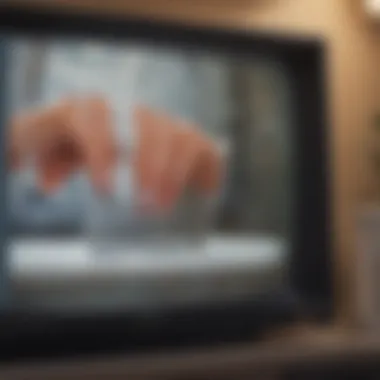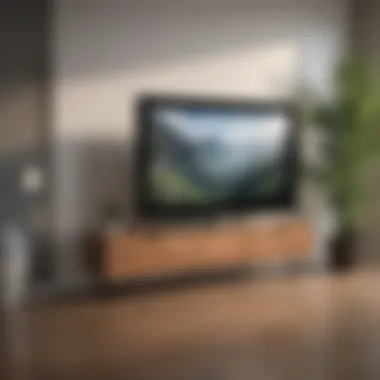Can You Safely Use Clorox Wipes on TV Screens?


Intro
The increasing reliance on electronic devices, particularly televisions, necessitates understanding how to clean these screens without causing harm. Among the most commonly discussed cleaning agents are Clorox wipes, notable for their convenience and disinfecting properties. However, their use on delicate surfaces like TV screens raises questions about safety and effectiveness.
This article delves into critical aspects concerning the compatibility of Clorox wipes with various types of television screens. We'll examine the ingredients contained within these wipes, the manufacturer's guidelines, and the inherent materials used in TV screen construction. The objective is to clarify the issues surrounding the application of Clorox wipes on electronic displays, ensuring consumers can maintain their devices while preserving their functionality and appearance.
By exploring both the technical specifications and practical advice, this guide will enhance understanding and provide clarity for consumers who may feel uncertain about the implications of using Clorox wipes on their television screens.
Preamble to Clorox Wipes
Clorox wipes are a staple in many households, known for their convenience and effectiveness in cleaning. They are pre-moistened disposable cloths that can quickly tackle a variety of surfaces. The relevance of this topic lies in the increasing reliance on these wipes for sanitizing not just kitchen counters and bathrooms, but also electronic devices, including TV screens. Given the sensitivity of screen materials, understanding the implications of using Clorox wipes directly on these surfaces is crucial.
Purpose of Clorox Wipes
The primary purpose of Clorox wipes is to provide an easy way to disinfect and clean various surfaces. These wipes contain cleaning agents that help remove germs, bacteria, and viruses from surfaces. Their formulation allows for a swift method of cleaning, making them particularly useful in environments where hygiene is essential, such as kitchens and restrooms. The versatility of Clorox wipes makes them attractive for those looking to maintain cleanliness efficiently.
Common Uses and Effectiveness
Clorox wipes are commonly used in various settings, such as homes, schools, and offices. Their effectiveness has made them a preferred choice for many. Here are some common applications:
- Wiping surfaces: Suitable for counters, tables, and doorknobs.
- Disinfecting toys: Many parents use these wipes to sanitize toys to keep children safe from germs.
- Screen cleaning: The convenience leads some to use them on devices like smartphones and TVs.
While they are effective at killing many types of germs, it is important to weigh their practicality against potential risks to delicate surfaces such as electronic screens. Clorox wipes may harm specific coatings or materials found on various types of displays. Understanding their composition and intended usage will guide consumers in making informed choices about cleaning methods.
Understanding TV Screen Types
In the realm of electronics, especially when it comes to televisions, understanding the type of screen you have is crucial. This knowledge directly informs the care and cleaning methods one should employ. Each screen technology has unique features and vulnerabilities. A misstep in cleaning could lead to permanent damage or diminished performance, rendering your investment less valuable.
Different screen types include LCD, LED, OLED, and Plasma. Each has distinct characteristics that influence how they respond to cleaning agents, including Clorox wipes.
and LED Screens
LCD (Liquid Crystal Display) and LED (Light Emitting Diode) screens, while often grouped together, have notable differences. Both types utilize liquid crystals to produce images, but LEDs employ a backlighting system that enhances brightness and color.
The surface of LCD and LED screens is generally more resilient than some other types. However, they are still sensitive to strong chemicals. Clorox wipes, with their disinfecting properties, may contain solvents that can strip the protective coatings on these screens. It’s essential to be cautious when cleaning them to prevent scratches or cloudiness.
OLED Technology
OLED (Organic Light Emitting Diode) technology represents a leap in display quality. Each pixel emits its own light, which allows for deeper blacks and improved contrast. While this technology offers superior picture quality, it is more sensitive to cleaning materials.
Using Clorox wipes on OLED screens can be risky. The chemical composition of these wipes could potentially harm the organic compounds in OLED panels. It’s recommended to consult the manufacturer's guidelines before applying any foreign substances to these delicate screens.
Plasma Screens
Plasma screens generally offer a high-quality viewing experience, particularly in terms of color and depth. However, they are less common today. The glass surface of a plasma screen can be more susceptible to scratches and can also benefit from gentle cleaning methods.


Similar to OLEDs, Clorox wipes may not be suitable for plasma screens due to the risk they pose against the screen's surface integrity. Excessive moisture or harsh chemicals can damage the delicate layers of a plasma display. As such, users should consider safer alternatives for regular maintenance.
Key Takeaway: Understanding the specific type of TV screen you possess is vital for determining the appropriate cleaning methods. Misapplication can lead to irreversible damage. Always check the guidelines of your specific manufacturer to avoid costly mistakes.
The Ingredients in Clorox Wipes
Understanding the ingredients in Clorox wipes is crucial for any consumer aiming to protect their television screens. Knowledge of these components helps to recognize any potential effects they might have on different surfaces, especially delicate electronics. Thus, this section will explore active ingredients and the possible risks associated with them to provide clarity for users.
Active Ingredients Overview
Clorox wipes contain a range of active ingredients that serve to disinfect and clean surfaces. The primary ingredient is quaternary ammonium compounds, specifically benzalkonium chloride. This substance is effective against various germs and bacteria, making it a popular choice for cleaning products. Additionally, Clorox wipes often include isopropyl alcohol, which also plays a role in cleaning by evaporating quickly and leaving no residue.
Apart from these, fragrances and dyes are sometimes added to enhance the user's experience, though they do not contribute to cleaning efficacy. It is important to note that these ingredients can be harsh and may not be suitable for all materials, particularly sensitive surfaces like those found on TVs.
Potential Risks to Electronics
While Clorox wipes can effectively eliminate germs, they pose certain risks to electronic screens. The two main concerns are damage to the screen coating and possible corrosion. LCD, LED, and OLED screens often have specialized coatings that can be compromised by harsh chemicals. Prolonged or improper use of Clorox wipes can lead to:
- Stripping of the screen’s protective layer: This layer helps reduce glare and improve picture quality.
- Streaking and clouding: Residues left behind can distort the image and make the screen harder to clean afterward.
- Chemical reactions: Some ingredients, such as isopropyl alcohol, can react negatively with specific materials that make up the screen.
"Always check manufacturer guidelines for safe cleaning alternatives. Using Clorox wipes without acknowledgment of screen types may result in costly damage."
Manufacturer Guidelines for Screen Cleaning
Understanding manufacturer guidelines for screen cleaning is crucial for any individual seeking to maintain their electronic devices safely. The recommendations provided by television manufacturers are based on extensive research and testing. Therefore, adhering to these guidelines can prevent damage and enhance the lifespan of screens.
Importance of Following Guidelines
When it comes to cleaning screens, there is often confusion about what is safe and effective. Many people may resort to using household cleaners or wipes without understanding their potential risks. Following the manufacturer’s instructions helps mitigate the likelihood of damaging sensitive screen coatings or components.
Recommendations from TV Manufacturers
TV manufacturers, such as Samsung, LG, and Sony, often provide detailed cleaning instructions within their user manuals. Common recommendations include:
- Use a microfiber cloth: This material is non-abrasive and effective at removing dust without scratching the surface of the screen.
- Dampen with water: Manufacturers typically advise against chemical cleaners. Instead, slightly dampening the microfiber cloth with distilled water is often encouraged.
- Avoid excessive pressure: When cleaning, applying light pressure is essential to prevent damage to the screen. Applying too much force can lead to screen defects or pixel damage.
- Regular maintenance: Instead of heavy cleaning sessions, routine dusting can limit the buildup of grime and reduce the need for deeper cleanings.
"Following the manufacturer's recommendations minimizes the risks of damage."
Cleaning Methods Endorsed
The endorsed cleaning methods vary by manufacturer but generally prioritize gentle and safe techniques. Here are some common strategies:
- Dry Cleaning: For routine maintenance, a dry microfiber cloth can be enough. This method effectively removes dust and small particles without using any moisture.
- Damp Cleaning: If necessary, manufacturers suggest using a slightly dampened cloth with plain water. It is prudent to avoid any cleaner that contains alcohol, ammonia, or strong solvents, as these ingredients can harm screen coatings.
- Avoiding Heat: Cleaning should not be done when the TV is heated. Letting the screen cool helps prevent thermal stress and potential damage from rapid temperature changes.
By following these guidelines, users can ensure that their devices remain in good condition while also being effective in cleaning them. Being vigilant about the specific guidelines laid out by manufacturers can save users from costly repairs or replacements.
Practical Considerations for Using Clorox Wipes
When cleaning electronic devices, particularly TV screens, the choice of cleaning product is paramount. Here, Clorox Wipes are frequently scrutinized due to their widespread use. Understanding practical considerations is vital for maintaining the integrity and functionality of screens.


Using Clorox Wipes offers advantages against germs and bacteria. They are designed to disinfect surfaces effectively. Consequently, this can decrease the risk of spreading harmful microorganisms within the home. Many consumers prioritize cleanliness, especially when devices are in shared spaces. However, one must weigh the benefits against potential downsides to electronic devices.
Effectiveness Against Germs and Bacteria
Clorox Wipes contain active ingredients aimed at eliminating germs. The primary component is sodium hypochlorite, a strong disinfectant. When used properly, these wipes can significantly reduce the presence of bacteria on surfaces, including TV screens. However, it is crucial to consider the surface material. For instance, disinfecting wipes may not be suitable for all types of screens.
The effectiveness of these wipes is not the only aspect to explore. Many users report that while the wipes do sanitize surfaces effectively, they sometimes end up causing build-up or streaking when used on screens. This highlights the need for users to follow guidelines on proper application methods. Effective cleaning can also involve using a separate, dry cloth after applying the wipe to ensure no residue remains behind.
Physical Effects on Screen Surfaces
While Clorox Wipes are efficient in removing germs, they can potentially damage screen surfaces over time. TV screens made of delicate materials such as LCD or OLED can be sensitive to harsh chemicals found in household cleaners, including Clorox. Users have reported issues like screen discoloration, streaking, or even physical damage when using these wipes improperly.
Furthermore, prolonged exposure to certain substances can lead to degradation of the anti-reflective coatings on screens. This means that while one may achieve a clean surface, the long-term effects could detrimentally impact visual quality.
Each television model may come with specific recommendations for cleaning, and adhering to these is particularly advisable. Users may opt for safer cleaning solutions, such as microfiber cloths lightly moistened with water or specific commercial screen cleaners. This ensures a balance between cleanliness and long-term screen health.
In summary, while Clorox Wipes provide a quick solution for disinfecting, users must approach their use on TV screens with caution. Being aware of both benefits and risks will aid in making informed choices for electronic care.
Alternatives to Clorox Wipes for Cleaning Screens
Finding safe and effective cleaning methods for TV screens is vital, especially considering the potential damage that cleaning products can inflict. Clorox wipes, while convenient, may carry risks for various screen types. Exploring alternatives is essential to not only ensure cleanliness but also maintain the integrity of the screen.
Microfiber Cloths
Microfiber cloths are one of the premier alternatives to Clorox wipes for cleaning screens. These cloths are made from synthetic fibers that are extremely fine. The unique texture allows the cloth to capture dust and dirt without scratching the delicate surfaces of TV screens.
Benefits of using microfiber cloths include:
- Non-abrasive: These cloths do not scratch screen surfaces, making them safe for use on all types of displays.
- Reusable: Unlike Clorox wipes, microfiber cloths can be washed and reused many times, which is more environmentally friendly.
- Efficient Cleaning: Microfiber can lift and trap particles effectively, often without the need for additional cleaning solutions.
To use a microfiber cloth, simply dampen it lightly with water. Avoid soaking, as excessive moisture can seep into the edges of the screen. Wiping in circular motions can help remove smudges without causing streaks.
Commercial Screen Cleaners
Commercial screen cleaners offer another viable option for maintaining clean TV screens. These products are specifically formulated for electronic screens, ensuring compatibility while still providing effective cleaning action. It is important to select a product that is free from harsh chemicals, as these can cause damage to display coatings.
Key considerations for using commercial screen cleaners include:
- Read Labels Carefully: Always check the ingredients list to ensure it does not contain ammonia or strong solvents.
- Follow Manufacturer Instructions: Each product may have specific application methods that yield the best results.
- Test Before Full Application: It is recommended to test any cleaner on a small, inconspicuous area of the screen first. This way, you ensure that the cleaner does not adversely affect the screen’s surface.
When applied correctly, commercial screen cleaners can provide streak-free clarity and effective sanitization.
DIY Cleaning Solutions
For those who prefer a more personalized approach, DIY cleaning solutions present an economical and customizable option. A simple combination of distilled water and white vinegar can effectively clean screens without introducing harmful chemicals. In many cases, this simple mixture can deliver satisfactory results while being safe for various screen types.
To create an effective DIY cleaner:


- Mix equal parts distilled water and white vinegar in a spray bottle.
- Spray the mixture lightly onto a microfiber cloth, rather than directly onto the screen.
- Use the cloth to wipe the screen gently.
Important notes when using DIY solutions include:
- Avoid Excess Moisture: Like with commercial cleaners, oversaturating the cloth can lead to damage.
- Consider Alternatives: If vinegar is not appealing in smell, other options like distilled water alone can be used, or adding a few drops of liquid soap can enhance cleaning power.
Overall, transitioning to alternatives for cleaning screens can enhance safety and prolong the life of electronic devices. The choice between microfiber cloths, commercial cleaners, and DIY solutions allows flexibility and customization based on user preferences.
User Experiences and Case Studies
User experiences can provide valuable insight when evaluating the safety of Clorox wipes on TV screens. Individuals who have used these products share both positive and negative stories that can shape consumer understanding and decision-making. It is essential to examine these experiences, as they highlight practical outcomes regarding electronic device maintenance.
Reported Damage from Clorox Wipes
Several users have reported damage to their TV screens after using Clorox wipes for cleaning. Common issues include:
- Discoloration: Some users observed that their screens changed color in certain areas, resulting in uneven visuals.
- Streaking: Many noticed streaks that did not easily wipe away, affecting the viewing experience.
- Surface Damage: Reports included scratches or cloudiness on the screen, making it less clear and vibrant.
These incidents indicate that there may be a risk when using Clorox wipes, particularly on sensitive screen types like OLED or plasma. The active ingredients can potentially react negatively with certain coatings, leading to degradation. Consumer feedback suggests exercising caution and more research is required to ascertain safety levels thoroughly.
Successful Cleaning Techniques
Amid the concerns, some users have shared successful cleaning techniques that minimize risk. Here are a few recommended methods:
- Diluted Solution Method: Some found that diluting Clorox wipes with water reduced the harshness of chemicals. This method helped prevent damage while still achieving cleanliness.
- Microfiber Cloth Use: Instead of applying Clorox wipes directly, using a microfiber cloth dampened with the solution encourages a gentler approach. This prevents excessive moisture from penetrating the screen.
- Spot Testing: Users recommend testing a small corner of the screen with a wipe before wider application. This step helps ensure compatibility with the screen finish.
"Always start with a microfiber cloth and a small amount of water. It's safer!" - A user review on Reddit.
These techniques indicate that while Clorox wipes are effective for many cleaning challenges, their application on TV screens must be approached with care. Balancing cleanliness and screen preservation is crucial, underscoring the importance of properly informing consumers about the risks and best practices.
Finale: A Balanced Approach
In examining the use of Clorox wipes on television screens, a balanced approach is essential for informed decision-making. This article highlights the significant interplay between sanitization needs and potential risks. Understanding the properties of both the cleaning product and the screen materials plays a crucial role in assessing safety.
Consumers must weigh the benefits of effective cleaning against the risk of damage to their electronic devices. Cleanliness is undoubtedly important, especially in the context of germs and bacteria that may accumulate on surfaces. However, certain screen types can be sensitive to harsh chemicals found in some cleaning products, including Clorox wipes.
By synthesizing both the recommendations from manufacturers and user experiences, one can draw valuable insights. A thorough understanding of these factors can lead to better maintenance routines that uphold the integrity of the devices while addressing cleanliness concerns effectively.
Summary of Findings
The examination of Clorox wipes reveals several key insights:
- Clorox wipes contain active ingredients that may not be suitable for all types of screens.
- Many TV manufacturers recommend avoiding those wipes, instead suggesting specific cleaning methods to maintain screen health.
- User experiences indicate mixed results, with some users reporting damage while others found success with proper technique.
These findings emphasize that while Clorox wipes serve a purpose in disinfecting surfaces, their application on TV screens is fraught with potential consequences. Understanding the ingredients and materials involved is vital.
Best Practices for Screen Care
Maintaining the quality of TV screens requires careful consideration of cleaning methods. Here are the best practices:
- Use a Microfiber Cloth: This is the preferred method among manufacturers. It effectively removes dust without scratching the screen surface.
- Apply Distilled Water or Specific Screen Cleaners: Use solutions designed for electronics. Commercially available products are often tested for safety on various screen types.
- Avoid Direct Application of Cleaners on the Screen: Instead, apply desired cleaning solution to the cloth first. This reduces the risk of liquid seeping into the device.
- Follow Manufacturer Recommendations: Each screen type has unique cleaning needs. Checking the user manual is a wise step.
- Regular Maintenance: Implement a routine cleaning schedule to prevent buildup of grime.
These practices help ensure functionality while minimizing risks associated with improper cleaning methods.



